Insights to Action: Gender and Financial Inclusion
Blog by Katie Kamins & Shelby Bourgault
Worldwide, women often face gender-specific hurdles in accessing financial services to meet the needs of their families and businesses. This was the focus of discussion at the International Center for Research on Women’s (ICRW) inaugural Insights to Action on June 29th when Dr. Sarah Gammage, Director of the Gender, Economic Empowerment & Livelihoods portfolio at ICRW and Lis Meyers, Senior Gender Specialist at Banyan Global, presented their findings on the barriers to women’s financial inclusion and how to address the gender-related social norms behind such barriers.
Insights to Action is an event series intended to spur dialogue, highlight project-derived insights and raise the level of transparency on the work that is being done within the gender space. It’s also a chance for ICRW staff — and guest speakers — to engage with an outside audience and share their research.
Dr. Gammage presented findings from a systematic review of the literature on gender and financial inclusion, supported by the Bill and Melinda Gates Foundation. The purpose was to identify key gaps in the literature, areas where people are not researching, but could have a positive impact on women’s financial inclusion, and to see how digital financial services could address some challenges to financial inclusion. To analyze this huge body of literature, the key areas of focus were access to and use of financial services, as well as outcomes of financial inclusion. The literature was further divided at the macro, meso and micro level, coded by region, methodology, and key themes or barriers that affect access and use of financial services.
Gammage highlighted some of the most well-researched benefits to individuals, households and national economies as a result of increased financial inclusion, including better management of income and the ability to invest more in human capital, education and nutrition. There are also particular ways in which women benefit when they gain access to financial services, such as greater autonomy in decision-making, increased ability to grow their businesses and more options to leave violent or abusive relationships. Gammage also highlighted the importance of understanding women’s preferences and gender norms when talking about increasing women’s access to and use of financial services. She explained that if financial services continue to move toward digital platforms, and women still do not have access to mobile phones, it is simple logic that their use of these services will not increase. Unpacking gender norms may help us to understand how better to support women’s financial inclusion.
Lis Meyers delved into her findings on the role gender norms play in creating barriers to women’s economic empowerment and access to market opportunities. Some of the norms she highlighted that affect women’s financial behavior include the expectation that women perform care work, the expectation that men are the head of the household and the perception that laws are “gender-neutral.” She stated that few financial sector programs are social norm transformative, meaning they do not seek to transform these underlying norms, but rather seek to work around them. It’s important to learn from transformative social norm change programming in other sectors, correct misconceptions and engage people at all levels (individual, household, community, and even state).
Norm change does not happen all at once. Meyers recommended social norm change programming, which would incorporate peer educators/role models, group dialogue and personal reflection through a multi-stage, multi-level approach. Additionally, it is essential to adapt approaches to relevant cultural settings in order to understand social, household, and individual barriers and design appropriate change processes. The resulting designs should increase the likelihood of effectively shifting gender-related social norms and promote sustainable and meaningful improvements to women’s financial inclusion.
Following the discussion, a number of the participants reinforced the importance of recognizing and accounting for social norms in research. Gammage and Meyers agreed that it is essential to take gender and social norms into account in order to understand why women have limited access to and use of financial services and how to overcome those challenges.
The Insights to Action program provided a thought-provoking breakdown of the barriers women face in accessing financial services. While this session was focused on financial inclusion, future Insights to Action sessions will bring different perspectives to how we can advance gender equality and empower women worldwide.
Katie Kamins recently served as the Communications Intern for ICRW. Prior to joining ICRW, Katie interned for the Hillary for America campaign as both a Research intern and a Communications fellow. She has also worked as a Campaigns Federal and Gubernatorial intern at EMILY’s List, as well as interned for both the Feminist Majority Foundation and Participant Media.
Katie is in her final year as an undergraduate student at the George Washington University, where she is majoring in Political Communication and minoring in Political Science.
To find out more about Katie, you can connect via LinkedIn.
Shelby Bourgault is Program Assistant for ICRW’s Gender, Economic Empowerment and Livelihoods portfolio. In this role, she has worked on topics including financial inclusion, economic empowerment and energy access.
Shelby graduated from Connecticut College, where she received her B.A. in International Relations and East Asian Studies.
To find out more about Shelby, you can connect via LinkedIn.
